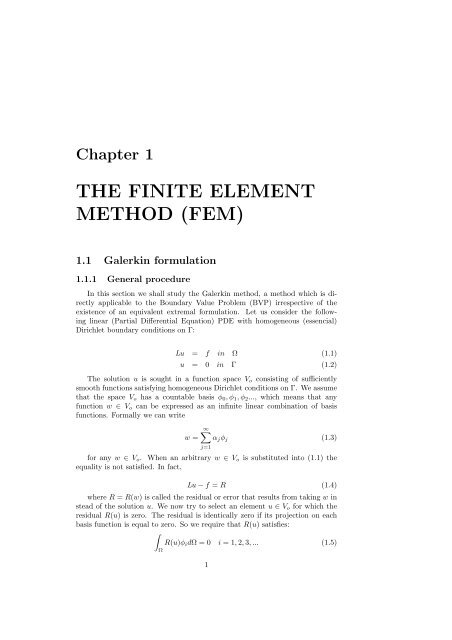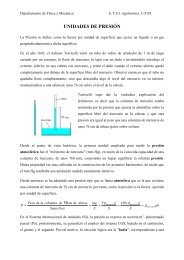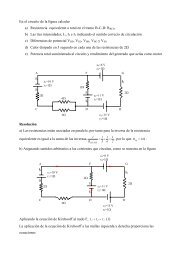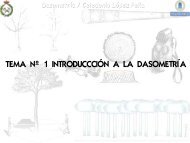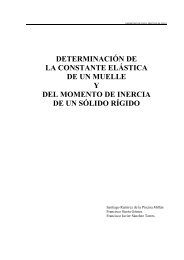THE FINITE ELEMENT METHOD (FEM) - OCW UPM
THE FINITE ELEMENT METHOD (FEM) - OCW UPM
THE FINITE ELEMENT METHOD (FEM) - OCW UPM
Create successful ePaper yourself
Turn your PDF publications into a flip-book with our unique Google optimized e-Paper software.
Chapter 1<br />
<strong>THE</strong> <strong>FINITE</strong> <strong>ELEMENT</strong><br />
<strong>METHOD</strong> (<strong>FEM</strong>)<br />
1.1 Galerkin formulation<br />
1.1.1 General procedure<br />
In this section we shall study the Galerkin method, a method which is directly<br />
applicable to the Boundary Value Problem (BVP) irrespective of the<br />
existence of an equivalent extremal formulation. Let us consider the following<br />
linear (Partial Differential Equation) PDE with homogeneous (essencial)<br />
Dirichlet boundary conditions on Γ:<br />
Lu = f in Ω (1.1)<br />
u = 0 in Γ (1.2)<br />
The solution u is sought in a function space V o consisting of sufficiently<br />
smooth functions satisfying homogeneous Dirichlet conditions on Γ. We assume<br />
that the space V o has a countable basis φ 0 , φ 1 , φ 2 ..., which means that any<br />
function w ∈ V o can be expressed as an infinite linear combination of basis<br />
functions. Formally we can write<br />
w =<br />
∞∑<br />
α j φ j (1.3)<br />
j=1<br />
for any w ∈ V o . When an arbitrary w ∈ V o is substituted into (1.1) the<br />
equality is not satisfied. In fact,<br />
Lu − f = R (1.4)<br />
where R = R(w) is called the residual or error that results from taking w in<br />
stead of the solution u. We now try to select an element u ∈ V o for which the<br />
residual R(u) is zero. The residual is identically zero if its projection on each<br />
basis function is equal to zero. So we require that R(u) satisfies:<br />
∫<br />
R(u)φ i dΩ = 0 i = 1, 2, 3, ... (1.5)<br />
Ω<br />
1
which implies<br />
∫<br />
Ω<br />
(Lu − f)φ i dΩ = 0 i = 1, 2, 3, ... (1.6)<br />
The order of differentiation in (1.6) can be lowered by performing an integration<br />
by parts (Green’s formula). Substitution of the boundary conditions<br />
leads to an expression of the form<br />
∫<br />
a(u, φ i ) = fφ i dΩ (1.7)<br />
which must be satisfied for i = 1,2,... The form a(., .) is bilinear (see the<br />
examples below). Let us remark that by the linearity of (1.7) with respect to<br />
φ i , (1.7) is equivalent to<br />
Ω<br />
F ind u ∈ V o such that<br />
∫<br />
a(u, φ i ) = fφ i dΩ (1.8)<br />
where the functions are called test functions. The Galerkin method now<br />
consists in taking a finite dimensional subspace V oN of V o spanned by N basis<br />
functions, say φ 1 ..., φ N . The approximate problem can then be defined as<br />
Ω<br />
which is equivalent to<br />
F ind ũ ∈ V oN such that<br />
∫<br />
a(ũ, φ) = fφdΩ ∀φ ∈ V oN (1.9)<br />
Ω<br />
F ind ũ ∈ V oN such that<br />
∫<br />
a(ũ, φ i ) = fφ i dΩ i = 1, 2, ....N (1.10)<br />
Ω<br />
The approximate solution ũ being a function in V oN has the form<br />
ũ =<br />
N∑<br />
α j φ j (1.11)<br />
j=1<br />
Substitution of (1.11) into (1.10) leads to the following system of linear<br />
algebraic equations for α 1 , ..., α N :<br />
N∑<br />
∫<br />
a(φ j , φ i ) =<br />
j=1<br />
Ω<br />
fφ i dΩ i = 1, 2, ....N (1.12)<br />
It may be clear that for the actual construction of the basis φ 1 , ..., φ N functions<br />
the <strong>FEM</strong> can be used most efficiently.<br />
Problem (1.8) is known as the weak (or variational) formulation of problem<br />
(1.1) and it is obtained starting from the BVP formulation. In order to prove<br />
that both formulations, the BVP and the variational problem, are equivalent,<br />
we still have to prove that a solution of the variational problem is actually a<br />
solution of the original BVP.<br />
2
When, instead of homogeneous Dirichlet conditions, the solution must satisfy<br />
inhomogeneous Dirichlet conditions u = g o on Γ, we write u as<br />
u = G o +<br />
∞∑<br />
α j φ j (1.13)<br />
where G o is such that G o | Γ = g 0 and φ 1 , ..., φ N vanish on Γ. The (equivalent)<br />
weak formulation then will be<br />
j=1<br />
F ind u ∈ V go such that<br />
∫<br />
a(u, φ) = fφdΩ ∀φ ∈ V o (1.14)<br />
Ω<br />
where V denotes the set of functions of the form (1.13):<br />
V go = V o + G o (1.15)<br />
The approximate problem is formulated as follows:<br />
where V goN = G o + V ON .<br />
F ind ũ ∈ V go N such that<br />
∫<br />
a(ũ, φ) = fφdΩ ∀φ ∈ V oN (1.16)<br />
Ω<br />
1.1.2 1D Poisson equation; Homogeneous boundary conditions<br />
Consider the following Poisson equation in 1D<br />
− d2 u<br />
= f<br />
dx2 on (0, 1) (1.17)<br />
with boundary conditions<br />
du<br />
u(0) = 0 (1) = 0 (1.18)<br />
dx<br />
We consider the function space V of sufficiently smooth functions that vanish<br />
at x = 0. Let φ ∈ V be arbitrary. It follows from (1.17) that<br />
∫ 1<br />
d 2 ∫<br />
u<br />
1<br />
−<br />
0 dx 2 φdx = fφdx (1.19)<br />
0<br />
Integration by parts of the left hand side gives:<br />
∫ 1<br />
0<br />
du dφ<br />
dx − [du<br />
dx dx dx φ]1 0 =<br />
∫ 1<br />
Since u(0) = 0 and du<br />
dx<br />
(1) = 0, (1.20) reduces to<br />
∫ 1<br />
0<br />
∫<br />
du dφ<br />
1<br />
dx dx dx =<br />
3<br />
0<br />
0<br />
fφdx (1.20)<br />
fφdx (1.21)
The variational formulation of problem (1.20), (1.20) reads now<br />
with a(u, φ) = ∫ 1<br />
0<br />
F ind u ∈ V such that<br />
a(u, φ i ) =<br />
du dφ<br />
dx dx dx.<br />
∫ 1<br />
0<br />
fφdx ∀φ ∈ V (1.22)<br />
In the space V we choose a finite number of basis functions φ 1 , ..., φ N . When<br />
the function space spanned by these basis functions is denoted by V N the approximate<br />
variational formulation reads:<br />
F ind ũ ∈ V N such that<br />
a(ũ, φ i ) =<br />
∫ 1<br />
0<br />
fφdx ∀φ ∈ V N (1.23)<br />
Writing ũ in the form<br />
N∑<br />
ũ = α j φ j (1.24)<br />
j=1<br />
then, (1.23) is equivalent to the following system of equations for α 1 , ..., α N .<br />
N∑<br />
∫ 1<br />
α j φ j φ i dx =<br />
∫ 1<br />
j=1 0<br />
0<br />
fφ i dx i = 1, 2, ....N (1.25)<br />
The <strong>FEM</strong> can be used to choose the basis functions. We subdivide the interval<br />
(0, l) into N subregions (subintervals), we choose the extremities of the<br />
subintervals as nodal points 0 = x 0 < x 1 < ...x N = 1. The basis functions<br />
φ i i = 1, 2, ..., N are then completely determined by the following three properties<br />
1. φ i (x j ) = δ ij i, j = 1, ...N.<br />
2. φ i is linear on each subinterval<br />
3. φ i is continuous on [0, 1].<br />
Then<br />
N∑<br />
ũ(x) = α j φ j (x) (1.26)<br />
j=1<br />
and the system of linear equations for ũ l , ..., ũ N becomes<br />
N∑<br />
∫ 1<br />
ũ j φ j φ i dx =<br />
∫ 1<br />
j=1 0<br />
0<br />
fφ i dx i = 1, 2, ....N (1.27)<br />
4
1.1.3 1D Poisson equation; non-homogeneous boundary<br />
conditions.<br />
Consider the Poisson equation<br />
with boundary conditions<br />
− d2 u<br />
= f on (0, 1) (1.28)<br />
dx2 du<br />
u(0) = g 0<br />
dx (1) = g 1 (1.29)<br />
We define the variable change û = u − u Γ , where u Γ is defined as:<br />
Now the problem can be written as:<br />
u Γ = g 0 if x = 0 (1.30)<br />
u Γ = 0 rest (1.31)<br />
− d2 (û + u Γ )<br />
dx 2 = f on (0, 1) (1.32)<br />
with the boundary conditions<br />
dû<br />
û(0) = 0<br />
dx (1) = g 1 (1.33)<br />
This new problem is an homogeneous one and it can be solved as we already<br />
know. The solution comes from the solution of the system for û l , ..., û N :<br />
N∑<br />
∫ 1<br />
û j<br />
j=1<br />
0<br />
dφ j<br />
dx<br />
∫<br />
dφ 1<br />
∫ 1<br />
i<br />
dx dx = fφ i dx − g 0<br />
0<br />
0<br />
dφ j<br />
dx<br />
dφ i<br />
dx dx + g 1φ i<br />
i = 1, 2, ....N<br />
(1.34)<br />
This system of equations differs only slightly from the one obtained with<br />
∫<br />
homogeneous<br />
Dirichlet-Neumann boundary conditions. Only the terms −g 1 dφ j<br />
0 0 dx<br />
and g 1 φ i have been added to the right hand side.<br />
To obtain the final solution we have to replace the original function u =<br />
û + u Γ , so:<br />
u =<br />
N∑<br />
û j φ j + u Γ (1.35)<br />
j=1<br />
which means adding g 0 locally at x = 0.<br />
It is important to remark that the solution of (1.34) means the solution of a<br />
linear system. Calling:<br />
b i =<br />
R ij =<br />
∫ 1<br />
0<br />
∫ 1<br />
0<br />
dφ j<br />
dx<br />
dφ i<br />
dx (1.36)<br />
dx<br />
fφ i dx − R ij g 0 + g 1 φ i (1.37)<br />
5<br />
dφ i<br />
dx dx
N∑<br />
R ij û j = b i (1.38)<br />
j=1<br />
1.2 Construction of a basis<br />
In this chapter we shall construct finite elements in the 1D case and also the<br />
construction of quadratic and cubic 1D elements will be discussed. To facilitate<br />
the construction of these elements we shall introduce the notion of barycentric<br />
coordinates. Next we introduce coordinate and element transformation and the<br />
notion of isoparametric finite element.<br />
1.2.1 Linear and quadratic functions in 1D<br />
Let us consider an arbitrary interval e = [x 1 , x 2 ] ⊂ [0, 1]. We define ∀x ∈ e<br />
the following functions λ 1 and λ 2 from [x 1 , x 2 ]<br />
λ 1 = x 2 − x<br />
x 2 − x 1<br />
λ 2 = x − x 1<br />
x 2 − x 1<br />
(1.39)<br />
These functions have the following properties:<br />
1. X is linear on e, i = 1,2.<br />
2. λ i (x j ) = δ ij .<br />
3. λ 1 (x) + λ 2 (x) = 1 ∀x ∈ e.<br />
The relation of the functions λ 1 and λ 2 to the 1D piecewise linear basis<br />
functions is evident. In fact, the basis function φ i corresponding to x i , i = 1, 2<br />
satisfies:<br />
1. φ i is linear on each subinterval.<br />
2. φ i is continuous on [0,1].<br />
3. φ i (x j ) = δ ij i, j = 1, 2.<br />
so that the restriction of φ i to e is precisely the function λ i (See Fig.1.1 (a)<br />
and (b)) For any point x ∈ e we can calculate the values of the functions X and<br />
h2. The pair {λ 1 (x), λ 2 (x)} is called the barycentric coordinates of the point x<br />
on e with respect to the points x and x. The 1D linear finite element is now<br />
defined as: (1.) a subdivision of [0,1] into subintervals, (2.) on each subinterval<br />
we choose two nodal points: the end points x 1 and x 2 of the subinterval, (3.)<br />
on each subinterval we define for each nodal point its basis function: on [x 1 , x 2 ]<br />
for instance<br />
φ 1 = λ 1 φ 2 = λ 2 (1.40)<br />
The function space spanned by φ 1 and φ 2 on e is denoted by P 1 (e), and<br />
contains all polynomials of degree ≤ 1 in x. Generally we denote by P k (e), k<br />
non-negative integer, e ⊂ R the function space of polynomials of degree < k in<br />
x 1 , x 2 , ..., x n . In other words, P k (e) is the function space spanned by x k1<br />
1 xk2 2 xk n n<br />
6
Figure 1.1: (a) Basis function φ i<br />
(b)The function λ i<br />
Figure 1.2: Linear shape function ũ on e<br />
with k i > 0, i = 1, ..., n, k 1 + k 2 + ... + k n < k. It follows that the shape function<br />
ũ takes the following form on e (see Fig.1.2)<br />
ũ(x) = ũ 1 φ 1 (x) + ũ 2 φ 2 (x) = ũ 1 λ 1 (x) + ũ 2 λ 2 (x) (1.41)<br />
Notice that, since the basis functions are linear on e, their derivatives are<br />
constant:<br />
dφ 1<br />
dx = dλ 1<br />
dx = −1<br />
x 2 − x 1<br />
dφ 2<br />
dx = dλ 2<br />
dx = 1<br />
x 2 − x 1 (1.42)<br />
The barycentric coordinates {λ 1 , λ 2 } can be used to define higher order basis<br />
functions in a very efficient way. Let us consider 1D basis functions that are<br />
quadratic on each subinterval. We assume that the interval [0,1] is subdivided<br />
into subintervals. To define uniquely a quadratic function on a subinterval<br />
e = [x 1 , x 2 ] we must fix its values in three different points. For this we choose<br />
on each subinterval e the following nodal points: the two end points which we<br />
call x 1 and x 2 and the mid-point x 12 = 1 2 (x1 + x 2 ) (See Fig.1.3)<br />
Let {λ 1 , λ 2 } be the barycentric coordinates of a point x ∈ e with respect<br />
to x 1 , x 2 . The function λ 1 is linear and λ i (x j ) = δ ij , i, j = 1, 2. Moreover<br />
λ 1 (x 12 ) = λ 2 (x 12 ) = 1 2 . Next we notice that λ 1(x 2 ) = 0 and λ 1 (x 12 ) − 1 2 = 0.<br />
Hence the function λ 1 (x)(λ 1 (x) − 1 2 ) vanishes at x = x2 and x = x 12 and is<br />
quadratic since both λ 1 and λ 1 − 1 2 are linear. For x = x1 the function takes<br />
the value λ 1 (x 1 )(λ 1 (x 1 ) − 1 2 ) = 1(1 − 1 2 ) = 1 2 .<br />
From this we deduce that the function<br />
φ 1 (x) = 2λ 1 (x)(λ 1 (x) − 1 2 ) (1.43)<br />
7
Figure 1.3: Element e with nodal points x 1 , x 2 and x 12<br />
Figure 1.4: Quadratic basis functions<br />
is the quadratic basis function on e corresponding to point x 1 .<br />
Similarly we find that<br />
φ 2 (x) = 2λ 2 (x)(λ 2 (x) − 1 2 ) (1.44)<br />
is the quadratic basis function on e corresponding to point x 2 .<br />
For point x 12 we remark that λ 1 (x 2 ) = 0, λ 2 (x 1 ) = 0 and that λ 1 (x 12 )λ 2 (x 12 ) =<br />
1 1<br />
which makes that the function<br />
2 2 = 1 4<br />
φ 12 (x) = 4λ 1 (x)λ 2 (x) (1.45)<br />
is the quadratic basis function on e corresponding to point x 12 .<br />
The three basis functions are depicted in Fig.1.4<br />
The function space spanned by φ 1 , φ 2 and φ 12 on e is denoted by P 2 (e) and<br />
consist of all polynomials of degree ≤ 2 in x 1 . The quadratic shape function<br />
takes now the following parabolic form on e See Fig.1.5.<br />
ũ(x) = ũ 1 φ 1 (x) + ũ 2 φ 2 (x) + ũ 12 φ 12 (x)<br />
= ũ 1 λ 1 (x)(2λ 1 (x) − 1) + ũ 2 λ 2 (x)(2λ 2 (x) − 1) + 4ũ 12 λ 1 (x)λ 2 (x) (1.46)<br />
8
Figure 1.5: Quadratic shape function ũ on e<br />
1.3 Triangular basis functions in 2D<br />
1.3.1 Barycentric coordinates<br />
In this section we shall use barycentric coordinartes to define linear, quadratic<br />
and extended quadratic basis functions in 2D. Let Ω be a 2D region which is<br />
subdivided into a finite number of triangles e k , k = 1, 2, ..., K, satisfying the<br />
properties (falta referencia). A linear function on a triangle e is completely<br />
determined by its values in-three non-collinear points, for example the vertices<br />
x 1 , x 2 and x 3 with coordinates x 1 = (x 1 1, x 1 2), x 2 = (x 2 1, x 2 2), x 3 = (x 3 1, x 3 2) We<br />
shall now define three functions λ i = λ(x), i = 1, 2, 3 on e by the following<br />
requirements<br />
1. λ i (x j ) = δ ij .<br />
2. λ i is linear on e<br />
These functions λ i can be calculated as follows: Take for instance λ 1 .Since<br />
λ 1 is linear it takes the following form:<br />
λ i = α 0 + α 1 x 1 + α 2 x 2 x = (x 1 1, x 1 2)<br />
Moreover we have<br />
λ 1 (x 1 ) = α 0 + α 1 x 1 1 + α 2 x 1 2<br />
λ 1 (x 2 ) = α 0 + α 1 x 2 1 + α 2 x 2 2<br />
λ 1 (x 3 ) = α 0 + α 1 x 3 1 + α 2 x 3 2 (1.47)<br />
System (1.47) can be solved for α 0 , α 1 and α 2 ; we find<br />
with<br />
α 0 = x2 1x 3 2 − x 3 1x 2 2<br />
∆<br />
α 1 = x2 2 − x 3 2<br />
∆<br />
α 2 = x3 1 − x 2 1<br />
∆<br />
∆ = (x 3 1 − x 2 1)(x 1 2 − x 2 2) − (x 2 2 − x 3 2)(x 2 1 − x 1 1)<br />
= ±twice the area of e<br />
9
Figure 1.6: Triangle e with particular points<br />
Similar expressions can be found for λ 1 and λ 3 . We easily verify that the<br />
following relation holds<br />
λ 1 (x) + λ 2 (x) + λ 3 (x) = 1 for all x ∈ e (1.48)<br />
For any point x ∈ e we can calculate the values of the functions λ 1 ,λ 2 and λ 3 .<br />
Now, similar to the definition in the 1D case, we call the triple {λ 1 (x), λ 2 (x), λ 3 (x)}<br />
the barycentric coordinates of the point x ∈ e with respect to the vertices<br />
x 1 , x 2 , x 3 . Let us calculate the barycentric coordinates of some particular points<br />
in a triangle e (see Fig.1.6).<br />
x 12 = 1 2 (x1 + x 2 ) mid-point of segment [x 1 , x 2 ]<br />
x 13 = 1 2 (x1 + x 3 ) mid-point of segment [x 1 , x 3 ]<br />
x 23 = 1 2 (x2 + x 3 ) mid-point of segment [x 2 , x 3 ]<br />
x 123 = 1 3 (x1 + x 2 + x 3 )<br />
barycentre of e<br />
x 1 → {1, 0, 0}<br />
x 2 → {0, 1, 0}<br />
x 3 → {0, 0, 1}<br />
x 12 → { 1 2 , 1 2 , 0}<br />
x 13 → { 1 2 , 0, 1 2 }<br />
x 23 → {0, 1 2 , 1 2 }<br />
x 123 → { 1 3 , 1 3 , 1 3 }<br />
10
Figure 1.7: λ-relations for some segments<br />
Notice also that points on the following segments satisfy a relation expressed<br />
in the barycentric coordinates:<br />
x ∈ [x 1 , x 2 ] ⇔ λ 3 (x) = 0<br />
x ∈ [x 1 , x 3 ] ⇔ λ 2 (x) = 0<br />
x ∈ [x 2 , x 3 ] ⇔ λ 1 (x) = 0<br />
x ∈ [x 12 , x 13 ] ⇔ λ 1 (x) = 1 2<br />
x ∈ [x 12 , x 23 ] ⇔ λ 1 (x) = 1 2<br />
x ∈ [x 13 , x 23 ] ⇔ λ 3 (x) = 1 2<br />
The situation is sketched in Fig.1.7<br />
Using these barycentric coordinates we shall now construct linear,quadratic<br />
and extended quadratic basis functions.<br />
1.3.2 Linear finite element<br />
For the construction of piecewise linear basis functions we take all the vertices<br />
of the triangles as nodal points:x 1 , x 2 , . . . , x N . A piecewise linear basis function<br />
φ i corresponding to nodal point x i is such that<br />
1. φ i (x j ) = δ ij i, j = 1, 2, . . . , N<br />
2. φ i is linear on each e k<br />
3. φ i is continuous on Ω<br />
We plainly verify that the basis function φ i is identically zero on those triangles<br />
for which x 1 is no vertex. Thus, let a triangle e with vertex x i be given.<br />
Introduce a local numbering of the vertices of e (see Fig.1.8<br />
The question now is: what is the shape on e of the basis functions φ i corresponding<br />
to the points x i , i=1,2,3. The function φ i is linear on e and satisfies<br />
φ i (x j ) = δ ij , i,j=1,2,3. So we see inmediately that<br />
φ 1 = λ 1 , φ 2 = λ 2 , φ 3 = λ 3 (1.49)<br />
11
Figure 1.8: Triangle e with nodal points x 1 , x 2 , x 1<br />
where {λ 1 (x), λ 2 (x), λ 3 (x)} denotes the barycentric coordinates of x with<br />
respect to the points x 1 ,x 2 ,x 3 .The function space spanned by φ 1 , φ 2 , φ 3 on e (the<br />
shape functions on e) is termed P 1 (e) and is exactly the collection of polynomials<br />
on e of degree ≤ 1 in x 1 and x 2 .<br />
1.3.3 Quadratic finite element<br />
A piecewise quadratic basis function φ has in 2D the general form:<br />
φ(x) = α 1 x 2 1 + α 2 x 1 x 2 + α 3 x 2 2 + α 4 x 1 + α 5 x 2 + α 6<br />
This implies that on each triangle φ must be specified by six values to determine<br />
the parameters α 1 , α 2 , . . . , α 6 . On each triangle we choose six nodal points:<br />
the three vertices and the three mid-points of sides. With local renumbering we<br />
have the situation of Fig.1.9.<br />
We shall determine the shape of the basis functions φ 1 , φ 2 , φ 3 , φ 12 , φ 13 , φ 23<br />
corresponding to the points x 1 , x 2 , x 3 , x 12 , x 13 , x 23 respectively.<br />
Take for instance φ 1 which vanishes in the nodal points x 2 , x 3 , x 12 , x 13 , x 23 and<br />
equals unity at x 1 . For all x ∈ [x 2 , x 3 ] we have λ 1 (x) = 0, for all x ∈ [x 12 , x 13 ]<br />
we have λ 1 (x) = 1 2 . Consequently the function λ 1(x)(λ 1 (x) − 1 2<br />
) vanishes at<br />
x 2 , x 3 , x 12 , x 13 , x 23 and equals 1 2 at x1 . The basis function φ 1 is thus defined by<br />
In the same way we obtain<br />
φ 1 = λ 1 (2λ 1 − 1) (1.50)<br />
φ 2 = λ 2 (2λ 2 − 1) (1.51)<br />
φ 3 = λ 3 (2λ 3 − 1) (1.52)<br />
For the basis function φ 12 we notice that segment [x 1 , x 3 ] satisfies λ 2 (x) = 0<br />
and that [x 2 , x 3 ] satisfies λ 1 (x) = 0. The function λ 1 (x)λ 2 (x) thus vanishes at<br />
x 1 , x 2 , x 3 , x 13 , x 23 and equals 1 4 at x12 . Hence φ 12 is defined by<br />
φ 12 = 4λ 1 λ 2 (1.53)<br />
12
Figure 1.9: Triangle e with six nodal points<br />
Similarly we have<br />
φ 13 = 4λ 1 λ 3 (1.54)<br />
φ 23 = 4λ 2 λ 3 (1.55)<br />
The function space spanned by φ 1 , φ 2 , φ 3 , φ 12 , φ 13 , φ 23 is called P 2 (e) and is<br />
precisely the space of polynomials of degree ≤ 2 in x 1 and x 2<br />
13


